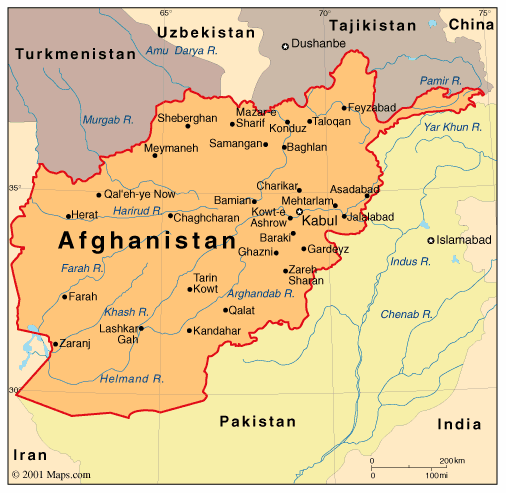AFGHANISTAN

Geography: Afghanistan, approximately the size of Texas, is bordered on the north by Turkmenistan, Uzbekistan, and Tajikistan, on the extreme northeast by China, on the east and south by Pakistan, and by Iran on the west. The country is split east to west by the Hindu Kush mountain range, rising in the east to heights of 24,000 ft (7,315 m). With the exception of the southwest, most of the country is covered by high snow-capped mountains and is traversed by deep valleys.
Government: In June 2002 a multiparty republic replaced an interim government that had been established in Dec. 2001, following the fall of the Islamic Taliban government.
History: Darius I and Alexander the Great were the first to use Afghanistan as the gateway to India. Islamic conquerors arrived in the 7th century, and Genghis Khan and Tamerlane followed in the 13th and 14th centuries.
In the 19th century, Afghanistan became a battleground in the rivalry between imperial Britain and czarist Russia for control of Central Asia. Three Anglo-Afghan wars (1839–1842, 1878–1880, and 1919) ended inconclusively. In 1893 Britain established an unofficial border, the Durand Line, separating Afghanistan from British India, and London granted full independence in 1919. Emir Amanullah founded an Afghan monarchy in 1926.
History: Darius I and Alexander the Great were the first to use Afghanistan as the gateway to India. Islamic conquerors arrived in the 7th century, and Genghis Khan and Tamerlane followed in the 13th and 14th centuries.
In the 19th century, Afghanistan became a battleground in the rivalry between imperial Britain and czarist Russia for control of Central Asia. Three Anglo-Afghan wars (1839–1842, 1878–1880, and 1919) ended inconclusively. In 1893 Britain established an unofficial border, the Durand Line, separating Afghanistan from British India, and London granted full independence in 1919. Emir Amanullah founded an Afghan monarchy in 1926.

Map of Afghanistan
President: Ashraf Ghani (2014)
Chief Executive: Abdullah Abdullah (2014)
Total area: 250,000 sq mi (647,500 sq km)
Population (2014 est.): 31,822,848 (growth
rate: 2.3%); birth rate: 38.8/1000; infant mortality rate: 117.23/1000;
life expectancy: 50.49; density per sq mi: 123.7
Capital and largest city (2011 est.):
Kabul, 3,097,300
Other large cities: Kandahar, 349,300;
Mazar-i-Sharif, 246,900; Charikar, 202,600; Herat, 171,500
Monetary unit: Afghani
National name: Jomhuri-ye Eslami-ye
Afghanestan
Languages:
Dari Persian, Pashtu (both official), other
Turkic and minor languages
Ethnicity/race:
Pashtun 42%, Tajik 27%, Hazara 9%, Uzbek 9%, Aimak 4%, Turkmen 3%, Baloch 2%, other 4%
Religion:
Sunni Muslim 80%, Shia Muslim 19%, other 1%
National Holiday:
Independence Day, August 19
Literacy rate: 28.1% (2000 est.)
Economic summary:
GDP/PPP (2013 est.):
$45.3 billion; per capita $1,100.
Real growth rate: 3.1% (2013
est.). Inflation: 6.8% (2013 est.). Unemployment: 35%
(2008 est.). Arable land: 11.95%. Agriculture: opium,
wheat, fruits, nuts; wool, mutton, sheepskins, lambskins. Labor
force: 15 million; agriculture 80%, industry 10%, services 10%.
Natural resources: natural gas, petroleum, coal, copper,
chromite, talc, barites, sulfur, lead, zinc, iron ore, salt, precious
and semiprecious stones. Industries: small-scale production of
textiles, soap, furniture, shoes, fertilizer, cement; handwoven
carpets; natural gas, coal, copper. Exports: $376 million; note
- not including illicit exports or reexports (2012): opium, fruits and
nuts, handwoven carpets, wool, cotton, hides and pelts, precious and
semiprecious gems. Imports: $6.39 billion (2012): capital
goods, food, textiles, petroleum products. Major trading
partners: Pakistan, India, U.S., Germany, Russia, China, Tajikistan.
Communications: Telephones: main lines
in use: 13,500 (2012); mobile cellular: 18 million (2012). Radio
broadcast stations: AM 21, FM 5, shortwave 1 (broadcasts in
Pashtu, Afghan Persian (Dari), Urdu, and English) (2007).
Television broadcast stations: at least 7 (1 government-run
central television station in Kabul and regional stations in 6 of the
34 provinces) (2007). Internet users: 1,000,000 (2012).
Transportation: Highways: total:
42,150 km; (2012).
Waterways: 1,200 km; chiefly Amu Darya, which handles vessels
up to about 500 DWT. Ports and harbors: Kheyrabad, Shir
Khan. Airports: 52 (2012).
International disputes:
World's largest producer of opium; poppy cultivation increased 57%,
from 115,000 hectares in 2011 to 180,000 hectares in 2012. The Taliban
and other antigovernment groups participate in and profit from the
opiate trade, which is a key source of revenue for the Taliban inside
Afghanistan; widespread corruption and instability impede counterdrug
efforts; most of the heroin consumed in Europe and Eurasia is derived
from Afghan opium; Afghanistan is also struggling to respond to a
burgeoning domestic opiate addiction problem; vulnerable to drug money
laundering through informal financial networks; regional source of
hashish (2013).
-------------------- o --------------------
No comments:
Post a Comment